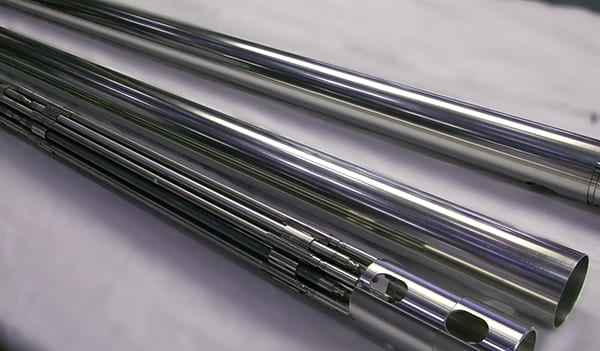
But, it’s really even worse than that, because not only does the nuclear industry not utilize vast amounts of useful fuel, it also has to manage the highly radioactive and long-lived leftovers. That costs money, and adds potential release and exposure issues to the risk matrix. It’s really not a logical way to do business. Furthermore, while spent nuclear fuel is and always has been managed in a safe and responsible manner in the U.S., it could be done in a much more environmentally friendly way by recycling the still-useful fuel and reducing the volume of material that requires storage or disposal.
A Complicated Process
Adkisson explained in an article posted on PNNL’s website that separating the usable parts of spent nuclear fuel from the unusable components is complicated. Spent nuclear fuel contains roughly half of the elements listed on the periodic table, so from a chemistry standpoint, there’s a lot to deal with. Dr. Gregg Lumetta, a lab fellow and chemist in PNNL’s Nuclear Chemistry and Engineering Group, suggested that to reduce proliferation risk, “it is best if pure plutonium is not produced at any point in the separation process.”
Using another analogy, Adkisson likened separating spent nuclear fuel to “trying to deconstruct vinaigrette salad dressing with the goal of moving ingredients from vinegar to oil.” The process is actually done by feeding a chemical slurry into a centrifuge system, which she said “looks like a giant pillbox with each compartment containing a rotor for mixing.” The solution flows from one end of the system to the other—mixing, centrifuging, adding, or subtracting different chemical components along the way. Throughout the process, real-time monitoring provides critical insights into adjustments that need to be made to maintain specific chemical compositions.
A Football Field Worth of Spent Nuclear Fuel
Although recycling spent nuclear fuel may seem like a no-brainer, some people might argue that it’s not worth the trouble. After all, there is only about 2,000 metric tons of used fuel generated in the U.S. each year at commercial nuclear power plants. To put that into perspective, consider that since the U.S. began generating power from commercial nuclear units in the 1950s, all of the reactors combined—133 total including some small prototype and test units that only operated for a handful of years—have produced about 87,000 metrics tons of spent nuclear fuel, and all of it could fit on a single football field at a depth of less than 10 yards.
Of course, spent nuclear fuel is not stored on a single football field—or in a federal geologic repository, as many experts would like it to be. Instead, commercial used fuel rods are stored at 76 reactor or storage sites in 34 states across the country. As previously noted, this is done safely and securely, but it could be done in a more sustainable and productive way.
Furthermore, spent nuclear fuel raises huge concerns outside of the nuclear industry, which is another reason recycling it could be worthwhile. The anti-nuclear crowd regularly touts the “nuclear waste problem” as a reason to avoid building new plants and to decommission existing reactors. Eliminating a big part of the problem through recycling removes a lot of the wind from their proverbial sails.
Others Recycle, More Options Are Coming
The World Nuclear Association (WNA) says China, Japan, Russia, and several European countries already have policies in place to reprocess spent nuclear fuel. In France, for example, reprocessing of oxide fuel has been done at La Hague since 1976, and two 800-ton-per-year plants are currently operating, according to the WNA. French utility EDF has reportedly made provisions to store reprocessed uranium for up to 250 years as a “strategic reserve.”
The DOE and its national labs have long supported research and development on a wide range of new advanced reactor technologies that could be game-changers for the nuclear industry. Among the advanced reactor designs are at least a couple that could consume or run on used nuclear fuel. Specifically, a sodium-cooled fast reactor (SFR) design, which uses liquid metal (sodium) as a coolant instead of water and uses a fast neutron spectrum, could use spent fuel from current reactors to produce electricity. It’s also been said that molten salt reactors (MSRs), which use molten fluoride or chloride salts as a coolant, can be tailored for the efficient burn-up of plutonium and minor actinides, which could allow them to consume waste from other reactors.
The point here is that spent nuclear fuel is not waste; it is a valuable resource. It should be considered a strategic reserve, similar to how the French and others seem to view it. Changing how people look at spent nuclear fuel—and what we do with it—could be vital to the future of the nuclear power industry.